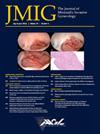诊室宫腔镜检查:作为高风险无症状患者筛查方法的意义。
IF 3.5
2区 医学
Q1 OBSTETRICS & GYNECOLOGY
引用次数: 0
摘要
研究目的为无症状的高危患者制定子宫内膜癌筛查策略。患者或参与者我们为高风险无症状患者制定了筛查方案,从 2003 年 1 月至 2023 年 1 月每三年对 OH 进行一次筛查。采用 Dotto 等人的宫腔镜风险评估分类。对 2076 名高风险患者(35-65 岁,平均年龄 51.4 岁)进行了研究,这些患者的风险因素包括肥胖、糖尿病、癌症病史、使用他莫昔芬、多囊卵巢综合征、激素替代疗法。高血压需要额外的风险因素才能入选。41 名患者被排除在外;最终人数为 2035 人。入选时均无症状。干预措施诊室宫腔镜检查。测量和主要结果针对无症状的子宫内膜癌高风险患者的筛查方案,每三年在目标群体中进行一次诊室筛查(OH)。从 2003 年到 2023 年,我们共为子宫内膜癌高风险患者进行了 14439 次子宫内膜癌筛查。结果:2003 年:27 例 AH(非典型增生) 24 例 CA(癌) PMDR 2.5%(恶性前病变+恶性肿瘤检出率) 2006 年:AH 22 例 CA 16 例 PMDR 2.5%(恶性前病变+恶性肿瘤检出率AH 22 CA 16 PMDR 1.93%, 2009 AH 24 CA 18 PMDR 2.25%, 2012:2012 年:AH 27 CA14 PMDR 3.32%,2015 年:AH 23 CA 13 PMDR 2.09%,2018 年:AH 29 CA 22 PMDR 3%,2021 年:AH 26 CA 15 PMDR 2.54%,2023 年:AH 28 CA 31 PMDR 3.09%:AH 28 CA 31 PMDR 3.66%.结论我们建议将诊室宫腔镜检查作为无症状子宫内膜癌高危患者的筛查方法。宫腔镜能在早期发现病变,从而扩大治疗窗口,为患者提供更大的治愈机会。这项技术使我们能够诊断出经阴道超声漏诊的子宫内膜癌和癌前病变。本文章由计算机程序翻译,如有差异,请以英文原文为准。
Office Hysteroscopy: Its Relevance as a Screening Method in High-Risk Asymptomatic Patients.
Study Objective
To develop a screening strategy for high-risk asymptomatic patients for endometrial cancer.
Design
Single Prospective Cohort.
Setting
Gynecological Medical Office. We did not use anesthesia.
Patients or Participants
We developed screening protocol for high-risk asymptomatic patients, conducting triennial screenings with OH from Jan 2003 to Jan 2023. Used Dotto et al. Classification for Hysteroscopic Risk Assessment. Studied 2076 high-risk patients (35-65 yo, mean age 51.4 yo) with risk factors including obesity, diabetes, cancer history, tamoxifen use, PCOS, HRT. Hypertension required an additional risk factor for enrollment. 41 patients excluded; final population 2035. All asymptomatic at recruitment. Diagnosed patients with endometrial cancer were removed from program for treatment.
Interventions
Office Hysteroscopy.
Measurements and Main Results
Screening protocol for high-risk asymptomatic patients for endometrial cancer, performing a screening office (OH) every three years in the targeted group. Between 2003 and 2023 we performed a total of 14439 OH in high-risk patients for endometrial cancer. Findings: 2003: 27 AH (Atypical Hyperplasia) 24 CA (carcinomas) PMDR 2.5% (Premalignant + Malignant Detection Rate) 2006: AH 22 CA 16 PMDR 1.93%, 2009 AH 24 CA 18 PMDR 2.25%, 2012: AH 27 CA14 PMDR 3.32%, 2015 AH 23 CA 13 PMDR 2.09%, 2018 AH 29 CA 22 PMDR 3% 2021 AH26 CA 15 PMDR 2.54% 2023: AH 28 CA 31 PMDR 3.66%.
Conclusion
We propose the use of office hysteroscopy as a screening method for high-risk for endometrial cancer asymptomatic patients. OH has the capacity of detecting lesions at an earlier stage, this widens the therapeutic window providing the patients with a greater chance of cure. This technique allowed us to diagnose endometrial cancer and premalignant lesions that were missed by transvaginal ultrasound.
求助全文
通过发布文献求助,成功后即可免费获取论文全文。
去求助
来源期刊
CiteScore
5.00
自引率
7.30%
发文量
272
审稿时长
37 days
期刊介绍:
The Journal of Minimally Invasive Gynecology, formerly titled The Journal of the American Association of Gynecologic Laparoscopists, is an international clinical forum for the exchange and dissemination of ideas, findings and techniques relevant to gynecologic endoscopy and other minimally invasive procedures. The Journal, which presents research, clinical opinions and case reports from the brightest minds in gynecologic surgery, is an authoritative source informing practicing physicians of the latest, cutting-edge developments occurring in this emerging field.

 求助内容:
求助内容: 应助结果提醒方式:
应助结果提醒方式:


